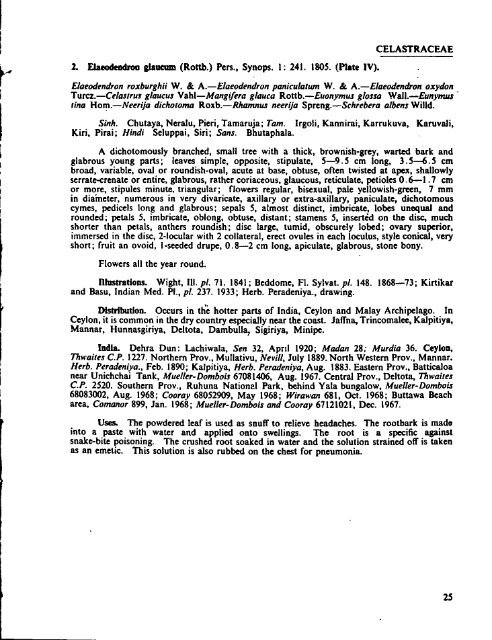,r\/*> - National Science Foundation
,r\/*> - National Science Foundation
,r\/*> - National Science Foundation
You also want an ePaper? Increase the reach of your titles
YUMPU automatically turns print PDFs into web optimized ePapers that Google loves.
2. Elaeodendroa glancom (Rottb.) Pers., Synops. 1: 241. 1805. (Plate IV).<br />
CELASTRACEAE<br />
Elaeodendroa roxburghii W. & A.—Eheodendron paniculatum W. & A.—Elaeodendron oxydon<br />
Turcz.—Celastrus glaucus Vahl—Mangifera glauca Rottb.—Euonymus glossa Wall.—Eunymus<br />
tina Horn.—Neerija dichotoma Roxb.—Rhamnus neerija Spreng.—Schrebera albens Willd.<br />
Sinh. Chutaya, Neralu, Pieri, Tamaruja; Tarn. Irgoli, Kannirai, Karrukuva, Karuvali,<br />
Kiri, Pirai; Hindi Seluppai, Siri; Sans. Bhutaphala.<br />
A dichotomously branched, small tree with a thick, brownish-grey, warted bark and<br />
glabrous young parts; leaves simple, opposite, stipulate, 5—9.5 cm long, 3.5—6.5 cm<br />
broad, variable, oval or roundish-oval, acute at base, obtuse, often twisted at apex, shallowly<br />
serrate-crenate or entire, glabrous, rather coriaceous, glaucous, reticulate, petioles 06—1.7 cm<br />
or more, stipules minute, triangular; flowers regular, bisexual, pale yellowish-green, 7 mm<br />
in diameter, numerous in very divaricate, axillary or extra-axillary, paniculate, dichotomous<br />
cymes, pedicels long and glabrous; sepals 5, almost distinct, imbricate, lobes unequal and<br />
rounded; petals 5, imbricate, oblong, obtuse, distant; stamens 5, inserted on the disc, much<br />
shorter than petals, anthers roundish; disc large, tumid, obscurely lobed; ovary superior,<br />
immersed in the disc, 2-1 ocular with 2 collateral, erect ovules in each loculus, style conical, very<br />
short; fruit an ovoid, 1-seeded drupe, 0.8—2 cm long, a pi cu late, glabrous, stone bony.<br />
Flowers all the year round.<br />
Illustrations. Wight, III. pi. 71. 1841; Beddome, Fl. Sylvat. pi. 148. 1868—73; Kirtikar<br />
and Basu, Indian Med. PI., pi. 237. 1933; Herb. Peradeniya., drawing.<br />
Distribution. Occurs in the hotter parts of India, Ceylon and Malay Archipelago. In<br />
Ceylon, it is common in the dry country especially near the coast. Jaffna, Trincomalee, Kalpitiya,<br />
Mannar, Hunnasgiriya, Deltota, Dambulla, Sigiriya, Minipe.<br />
India. Dehra Dun: Lachiwala, Sen 32, April 1920; Madan 28; Murdia 36. Ceylon,<br />
Thwaites CP. 1227. Northern Prov., Mullativu, Nevill, July 1889. North Western Prov., Mannar.<br />
Herb. Peradeniya., Feb. 1890; Kalpitiya, Herb. Peradeniya, Aug. 1883. Eastern Prov., Batticaloa<br />
near Unichchai Tank, Mueller-Dombois 67081406, Aug. 1967. Central Prov., Deltota, Thwaites<br />
CP. 2520. Southern Prov., Ruhuna <strong>National</strong> Park, behind Yala bungalow, Mueller-Dombois<br />
68083002, Aug. 1968; Cooray 68052909, May 1968; Wirawan 681, Oct. 1968; Buttawa Beach<br />
area, Comanor 899, Jan. 1968; Mueller-Dombois and Cooray 67121021, Dec. 1967.<br />
Uses. The powdered leaf is used as snuff to relieve headaches. The rootbark is mado<br />
into a paste with water and applied onto swellings. The root is a specific against<br />
snake-bite poisoning. The crushed root soaked in water and the solution strained off is taken<br />
as an emetic. This solution is also rubbed on the chest for pneumonia.<br />
25
















